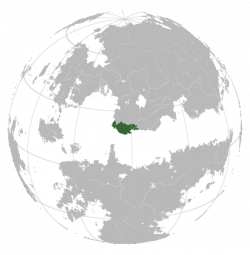Kingdom of Siyezan
| Kingdom of Siyezan | |||||
| Seyínta Síyezan Seyínta Síyezan | |||||
| |||||
| Anthem Seyba gosit Royal salute | |||||
| Capital | Çinévin | ||||
| Government | Unitary parliamentary constitutional monarchy (de jure) | ||||
| Monarch | |||||
| • | 1800-1814 | Vanali I (first) | |||
| • | 1933-1942 | Ardzin III (last) | |||
| Prime minister | |||||
| • | 1800-1804 | Éndrzein Tsevşa (first) | |||
| • | 1934-1942 | Jilkam Sújba (last) | |||
| Legislature | Council of Siyezan | ||||
| History | |||||
| • | Colapse of the Personal Union | 1800 | |||
| • | Republic proclaimed | 1944 | |||
| b. | ... | ||||
The Kingdom of Siyezan is the period of Siyezi history covering the establishment of the First Vos Republic and the subsequent collapse of the personal union between both countries (1800) and the modern Second Republic of Siyezan (1944), a total of 144 years, during which the country was ruled as a monarchy mostly uninterruptedly. This period saw a fragile democracy, where royal decrees often overpowered democratic decisions, ruling over the industrialisation of the country and many global shifts in power dynamics and major conflicts like the White War and the War of Supremacy.
History
Vos Revolution and the fall of the Personal Union
The Kingdom of the Arashend and Juqashat had been a part of the Holy Shanyedate ever since the 16th century, as a result of complex relationships between Vos dynasties of the Shanyedate and local siyezi dynasties, ever since the end of the Yeshub. King [] had been crowned Shanyeda and King of the Arashend and Juqashat in the kate 18th century, ruling over an increasingly unstable realm. The outbreak of the Vos Revolution in 1800 led the Kingdom of the Arashend and Juqashat to a decision, allowing the former Shanyeda to continue his rule over the country. However, this option was quickly rejected by the siyezi nobility, due to fear of a diplomatic crisis with the new Vos republican government and a sentiment of dissatisfaction with how they were treated in the union.
This decision lead to the election of Vanali Yécosahba, of the Yécosahba dynasty, a local dynasty that had been Komanised during the Great Horde's control of thr Juqashat, by the nobles' council. This highly debated election strove to set the country's path apart from Vosan.
First years
Vanali I's first major action was officially renaming the country to the Kingdom of Siyezan, a name already used by emerging nationalist groups, in an effort to definitely unite both historic halves (Arashend in the west and Najuqashat in thr east) of the country.
Immediately, the country found itself in an uncomfortable situation: Vosan was in disarray, and their republican ideals had spread to the country. The Terminal Empire had |Yeshub in the 14th century, and this was further agravated by thr favt that the former Great Horde was disunited and the Terminian Empire seemed stronger than during the 14th century. (To be expanded)
The Treaty of Mirgadam
As soon as the Vos monarchy was restored, Siyezan offered an alliance against Terminia.
The Treaty of Mirgadam (Damserz: _Mirgadamey Metháyo_, Vos: ) established military and economic cooperation between both countries: both had legitimacy to call eachother for military aid and the other was obliged to respond. However, in economic matters, it established that "economic policies, such as tariffs, or disallowing certain goods due to their origins or quality are to be coordinated to the fullest extent between both nations". However, due to Vosan's economy being much larger than Siyezan's, some restrictions could be used by Vosan but could seriously harm the siyezi economy. Before the signing of the treaty, this clause was filtered to the press, which portrayed the treaty as "Siyezan being sold to Vosan". This caused outrage back in Siyezan, resulting in protests across the country. As a result, an addendum was established: this "economic synchronization" could only be fully attempted during an open war.

